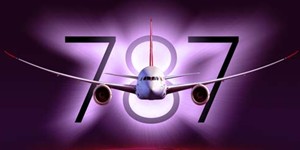Boeing revamps Dreamliner batteries; to get airborne ‘in weeks’
16 Mar 2013
US aircraft manufacturer Boeing Co said on Friday that a proposed redesign of the 787 Dreamliner's battery systems could allow commercial flights to restart within weeks, after all Boeing 787 planes in operation with airlines across the world were grounded in mid-January following two fire incidents.
 Company officials for the first time detailed their proposed fixes for the lithium-ion batteries to which the problem was traced aboard its 787 planes. The changes include better insulation between the eight cells in the battery, gentler charging to minimise stress and a new titanium venting system.
Company officials for the first time detailed their proposed fixes for the lithium-ion batteries to which the problem was traced aboard its 787 planes. The changes include better insulation between the eight cells in the battery, gentler charging to minimise stress and a new titanium venting system.
The Federal Aviation Administration approved these changes on Tuesday, and Boeing has since begun a series of 20 certification tests that it expects to wrap up in one to two weeks. Most of the tests will be conducted inside Boeing labs with only a single test flight planned, since the plane's two batteries are not used while in normal flight.
The 50-odd 787s delivered to airlines so far have all been grounded since mid-January after the battery on one plane ignited while parked in Boston and another Japan Airlines (JAL) 787 made an emergency landing soon after take-off when it began to smoke.
''This (new features) keeps us from ever having a fire in the beginning,'' Mike Sinnett, the 787's chief engineer, said during a news conference in Japan along with Ray Conner, the president and chief executive of Boeing's commercial airplane division. ''It eliminates the possibility for fire.''
Sinnett said that Boeing engineers had identified 80 different ways that the batteries could fail and modified the batteries as a result. But if, for whatever reason, a cell did overheat and combust, a steel casing would contain the smoke and fire, the venting tube would open, and the smoke would be pushed outside the plane instead of venting inside the cabin.
The presence of senior Boeing officials in Japan reflected the central role that Japanese companies have played in financing and manufacturing the planes. Japanese authorities also need to approve Boeing's new design.
The lithium-ion battery is made in Japan by GS Yuasa, which Conner called ''a tremendous partner.''
During the presentation, Boeing also disputed characterisations made by the National Transportation Safety Board in its investigation of the Boston episode. The safety board has described it as a fire event that was caused when a failure in one cell cascaded to others, in what the board referred to as a thermal runaway.
Boeing executives took issue with both assertions, contending there never was a fire inside the battery. They pointed out that the only eyewitness report referred to two three-inch flames on the connectors outside the battery box. The second episode involved only smoke.
In a report last week, the safety board said that firefighters reported ''radiant heat waves'' along with considerable smoke, but no flames, and one firefighter was burned in the neck when the battery exploded.
Boeing's solution, which company officials call comprehensive and permanent, involves using the same battery cells and blue-box aluminum casing. The cells from the existing batteries will be retested and repurposed.
The batteries' original insulation made of polyvinyl chloride, or PVC, can withstand heat of 300 degrees Fahrenheit. Instead, the cells will now be wrapped with another insulating material called phenolic glass laminate, made of thin layers of a fiberglass material and resin, with a resistance of more than 900 degrees.
Boeing is also taking steps to reduce vibrations inside the battery that might have been one of the possible causes of the short circuits.
The changes to the two batteries will add 150 pounds to the weight of the airplane - a small addition to the 350,000 pound jet, but enough to offset the weight advantage from using the lighter lithium-ion batteries in the first place.
Boeing said it had been testing its new system for the last six weeks and found that the steel casing could withstand three times the pressure generated when a battery suffered a catastrophic failure.
''We think the likelihood of a repeat event is very unlikely,'' Ron Hinderberger, a senior Boeing 787 engineer, said in a conference call on Friday.





















